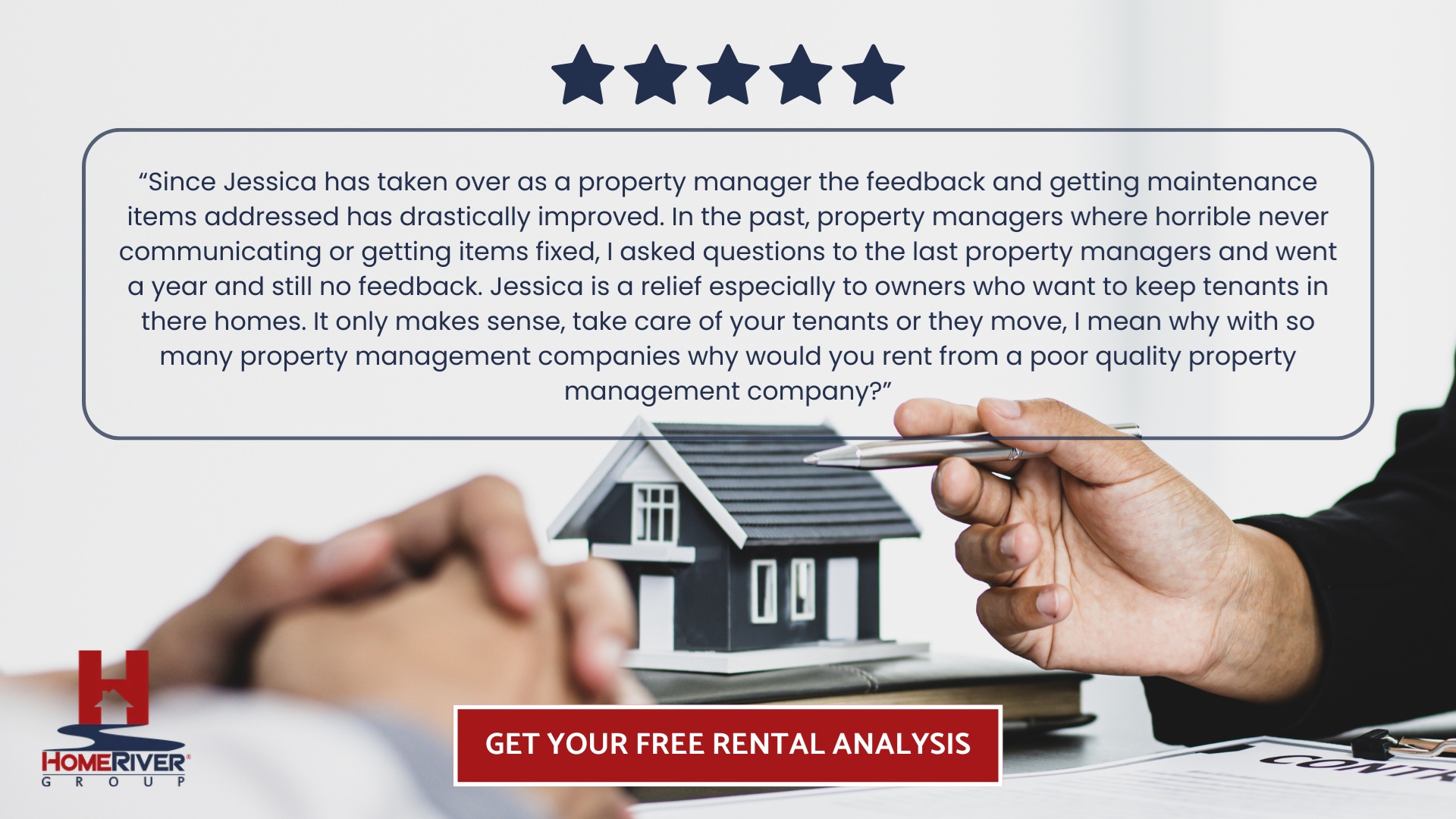
At HomeRiver Group, we bring together local market expertise, proven systems, and national reach to deliver unmatched property performance. From rent collection to regulatory compliance, we handle every detail with precision. Our team empowers property owners with full-service solutions, transparent reporting, and consistent results. When you partner with HomeRiver Group, you gain more than management—you gain a trusted ally in your investment success.
Managing security deposits in California requires more than collecting a check and hoping for the best. State laws clearly define how much you can charge, what deductions are allowed, and how quickly you must return funds. Whether you’re a seasoned landlord or new to property management, understanding the rules is essential to avoid legal trouble and maintain trust with your tenants. A little knowledge can go a long way in protecting your business.
In this blog, we will explore the key provisions of California security deposit law, including maximum deposit limits, valid deduction categories, and the legal timeline for returning funds—equipping landlords with the clarity they need to stay compliant and avoid costly disputes.
Understanding California Security Deposit Limits
When renting a property in California, you must be aware of the state's strict limits on security deposits. The law is explicit: You cannot ask for more than two months’ rent as a security deposit for an unfurnished residential property. If the unit is furnished, the limit increases to three months’ rent. This cap includes pet deposits, cleaning fees, or any amount collected in advance to cover potential damages or unpaid rent.
Understanding What Counts As A Security Deposit
California differentiates a security deposit from other fees like application fees or the first month’s rent. Only funds collected explicitly to cover potential tenant-caused damage or unpaid obligations fall under the security deposit category. Charging more than the legal limits can expose you to legal and financial penalties. You’re also required to provide tenants with a receipt for the deposit and a detailed description of any deductions at the end of the lease.
Why Compliance Protects Your Investment
Keeping meticulous records and adhering to these limits isn’t just about obeying the law—it’s about protecting your investment and maintaining positive landlord-tenant relationships. Always document the property condition at move-in and move-out, so if a dispute arises about the deposit, you have clear records to support your position. For those working with a management company, it’s wise to ask how property management fees in California are structured and whether deposit handling is included as part of their compliance services.
Acceptable Uses For Security Deposits
Understanding how security deposits can be rightfully used is crucial in maintaining transparency with your tenants and staying compliant with California security deposit law. As a landlord, you can deduct from the security deposit only for specific reasons clearly outlined in state statutes. Documenting any charges and providing clear communication is essential to avoid disputes.
Covering Unpaid Rent Obligations
The security deposit can be used to cover unpaid rent. If a tenant leaves without paying the last month’s rent, the deposit may be applied toward what is owed.
Addressing Property Damage Beyond Wear And Tear
Beyond unpaid rent, security deposits can also address the cost of repairing damages beyond normal wear and tear. For example, if walls are left with large holes or carpets are stained beyond typical usage, those costs are considered valid deductions. Using a rental property inspection checklist during move-in and move-out helps clarify the property's condition and supports fair, well-documented deductions.
Cleaning To Original Standards
Cleaning is another allowable use, but only to bring the unit back to the level of cleanliness it had at move-in. Be sure to keep receipts and before-and-after photos, as tenants can challenge deductions they feel are unfair.
Replacing Or Repairing Tenant-Damaged Items
You may also subtract amounts needed to replace or repair personal property—like appliances or fixtures—that the tenant damaged. Again, the condition should exceed what you’d expect from everyday use.
Making The Right Distinctions
It’s critical to distinguish between “normal wear and tear” (such as faded paint or minor carpet scuffs, which are not deductible) and actual damage (such as broken windows or pet urine that ruins flooring, which is). Making this distinction and maintaining solid records will protect you and your tenants under California law.
Penalties For Wrongful Withholding
Navigating California security deposit law requires diligence, because mistakes can lead to substantial penalties.
Strict Legal Obligations For Deposit Returns
If you wrongfully withhold any portion of a tenant’s security deposit, whether by missing the 21-day deadline to return it, failing to provide an itemized deduction statement, or keeping funds without legitimate justification, the legal consequences can be significant. Knowing how long does landlord have to return deposit is fundamental, as exceeding the 21-day window without proper documentation can trigger legal action.
Financial Penalties For Bad Faith Withholding
Under California Civil Code §1950.5, a landlord who acts in bad faith when retaining a tenant's security deposit may be liable for damages up to twice the amount withheld, in addition to repaying the original sum. For example, if a $2,000 deposit is wrongfully withheld, courts may award tenants up to $4,000 in penalties, plus the return of the initial $2,000 deposit. This statute is enforced strictly, especially if the tenant can prove the landlord acted deliberately or negligently.
Additional Costs From Legal Disputes
Legal disputes over security deposits often end up in small claims court, where outcomes hinge on detailed documentation. A landlord who cannot produce complete records, receipts, or proof of communication may find the decision favors the tenant. These proceedings can also involve court fees and legal expenses, compounding the cost of noncompliance.
Protect Yourself With Timely, Transparent Action
To avoid penalties, always return the correct deposit amount within the legal timeframe, provide a clear breakdown of any deductions, and maintain thorough records of move-in and move-out inspections, repairs, and tenant correspondence. This proactive approach promotes compliance and shields you from unnecessary financial and legal risk.
Your Rights And Responsibilities As A Landlord
Navigating California security deposit law requires clarity on your rights and obligations as a landlord. State regulations set strict guidelines regarding handling, storing, and returning security deposits to ensure fairness throughout the leasing process.
Legal Rights To Collect And Limitations On Amounts
First, you can collect a security deposit before a tenant moves in. California law limits the maximum amount: for an unfurnished residential property, the cap is the equivalent of two months’ rent, and for a furnished rental, it’s up to three months’ rent. If you accept pets, you can include additional cleaning fees as part of the deposit, but the total amount must not exceed these statutory limits.
Proper Handling And Storage Of Funds
Once you’ve collected a deposit, you must store the funds in a way that distinguishes tenant money from personal or business operating funds. While California doesn’t require you to keep security deposits in a separate interest-bearing account, maintaining clear records safeguards against disputes.
Allowable Deductions And Documentation
It's crucial to understand that these funds belong to the tenant until there’s a legitimate need for deductions when they move out. You can withhold portions of the deposit to cover unpaid rent, repair damages beyond normal wear and tear, and pay for cleaning if the property is less clean than at move-in. However, “normal wear and tear” is not a valid reason for deduction. Document the property’s condition with written records and photos at both move-in and move-out to substantiate any claims.
Return Deadlines And Legal Penalties
Under California law, you are responsible for returning the security deposit, or a written itemization of deductions with any remaining funds, within 21 days of the tenant vacating the property. Failing to meet this deadline can result in penalties and legal liability, including potential damages owed to the tenant.
Upholding Fair Housing And Application Practices
Clear communication, thorough documentation, and compliance with state guidelines help you uphold your legal responsibilities and avoid common pitfalls when managing security deposits. It's also worth understanding does a landlord have to give a reason for not renting. While California law does not always require landlords to disclose reasons, doing so can support transparency and defend against any perception of discrimination. Any denial must comply with Fair Housing laws and be based strictly on objective criteria such as credit, income, or rental history.
Common Mistakes To Avoid With Security Deposits
Even seasoned landlords can find themselves tripped up by California security deposit law. A simple oversight can lead to costly disputes, damaged relationships, or legal trouble.
These are some of the common pitfalls you’ll want to steer clear of:
Charging Over The Legal Limit: California sets strict caps on how much you can collect for a security deposit: no more than two months’ rent for unfurnished units, and three for furnished ones. Charging a penny more is a violation, regardless of special circumstances.
Neglecting Written Documentation: Failing to provide an itemized receipt or to document move-in conditions can come back to haunt you. Always offer a detailed list of deductions, receipts, or invoices if you retain any part of the deposit. Comprehensive photographic evidence and thorough move-in/move-out checklists serve as added protection.
Missing The Refund Deadline: California law requires you to return the tenant’s security deposit, or the remainder, within 21 days of move-out. Sending it late—even by a day—can result in penalties and jeopardize future claims.
Improper Deductions: Deducting for normal wear and tear is against the rules. You can only withhold funds for unpaid rent, necessary cleaning, or repairs for damages exceeding ordinary use. Gray areas should always be resolved in favor of what you can justify.
Failing To Communicate: Open communication with tenants about the status and handling of their security deposit is essential. Unanswered questions or ignored requests for explanation are likely to escalate into disputes. Proactive updates prevent misunderstandings and reduce the risk of legal escalation.
Establishing trust early in the leasing process can help you avoid these issues. Tools like renter screening questions, the ultimate guide to finding the right tenants, can guide your selection process, helping ensure you start with reliable renters and minimizing future conflicts over deposits or damages.
Final Thoughts
Understanding California security deposit law can be intricate, but staying compliant is essential for protecting your property investment and fostering positive relationships with residents. By clearly understanding the statutory limits, timing, and permissible deductions, you reduce your risk of legal disputes and build trust with your tenants. Remember, transparency and accurate recordkeeping are vital every step of the way.
At HomeRiver Group, we leverage our decades of property management experience, localized market knowledge, and centralized resources to help property owners comply with ever-evolving regulations, such as California’s security deposit laws.
Property management is about proactive risk mitigation and detailed attention to legal obligations. As the premier national property management company, HomeRiver Group puts your property first so you can confidently focus on your investment strategy. If you have questions about the California security deposit law or want to ensure your properties are managed to the highest standard, contact our experts today.
Read also:
Rules For Renting A Room In Your House: Legal And Practical Tips
How Tariffs Impact Mortgage Rates: What Homeowners And Landlords Should Know
Frequently Asked Questions About California Security Deposit Law
What is the maximum security deposit a landlord can charge in California?
Under California law, if you’re renting out an unfurnished residential property, you can charge up to two months’ rent as a security deposit. For furnished properties, the limit is three months’ rent. These caps apply to tenants and landlords, regardless of how the deposit is labeled.
How long must a landlord return the security deposit after a tenant moves out?
You are legally required to return a tenant’s security deposit, with an itemized statement of any deductions, within 21 days after they move out. Missing this deadline can expose you to penalties and potential legal action.
What can a landlord deduct from the security deposit?
You can use the security deposit to cover unpaid rent, repair damages beyond normal wear and tear, and clean the unit if it was dirtier than when the tenancy began. Routine painting, small nail holes, and minor carpet wear generally fall under normal wear and tear and cannot be deducted.
Is a walk-through inspection required before refunding the security deposit?
Yes. California law entitles tenants to request a pre-move-out inspection. You must give tenants written notice of this right. The inspection enables tenants to address potential deductions before moving out, giving both parties transparency over the condition of the unit.
Can a landlord require a non-refundable security deposit?
No. All security deposits are fully refundable under California law. Any attempt to label a deposit or a portion of it as “non-refundable” is not allowed, regardless of the lease language.
Do landlords have to pay interest on security deposits in California?
California does not require landlords to pay interest on security deposits nationwide. However, some cities, such as Los Angeles and San Francisco, may require interest payments. Check with your local jurisdiction to confirm if this rule applies.
How should a landlord store a tenant's security deposit?
Security deposits must be held to allow you to return the full balance, minus lawful deductions, at move-out. There is no statewide mandate to keep the deposit in a separate account, but you must never use it as personal funds or commingle it with operational income.
What should be included in the security deposit refund letter?
Your refund letter should itemize all deductions, specifying what was taken out and why. Attach receipts or invoices for any repairs or cleaning if the deductions exceed $125. Transparency is key—ensure your explanation is detailed and matches actual expenses. Provide the refund letter and any remaining deposit within the 21-day timeframe.











